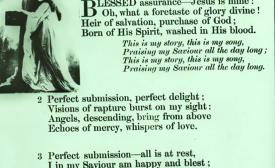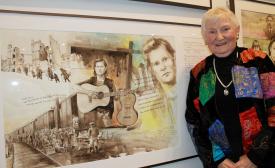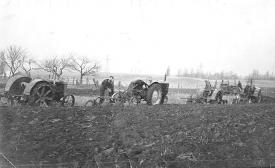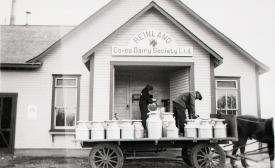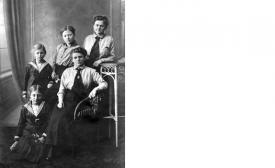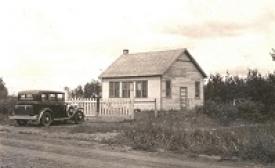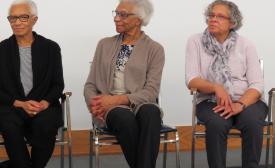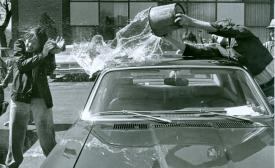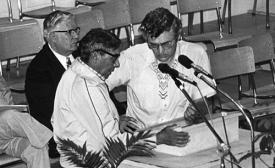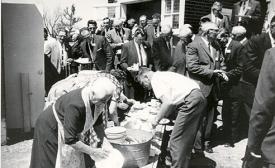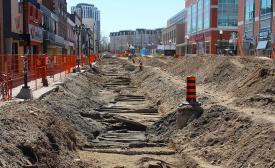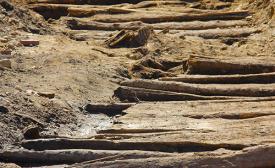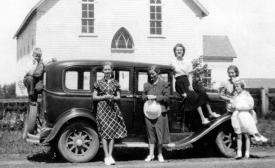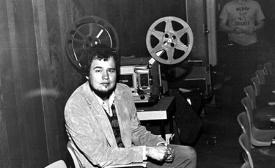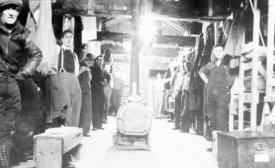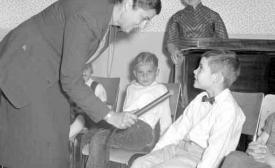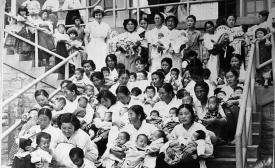Mennonite history
Singing off the wall
The phrase “singing off the wall,” referring to singing from projected words rather than a hymn book, first appeared in Canadian Mennonite in 2010. This image shows that the practice went back much further. Stirling Avenue Mennonite Church in Kitchener, Ont., recently donated a collection of glass “lantern slides” probably in use circa 1924-45.
‘Along the Road to Freedom’ exhibit tours Alberta
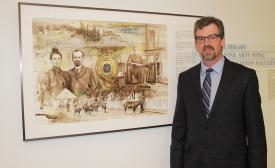
Tim Wiebe-Neufeld stands beside the Ray Dirks painting that tells the story of Maria Friesen Neufeld, his great grandmother, one of the courageous Mennonite women who brought their families out of the hardships and terror of the Soviet Union in the early 1900s. (Photo by Donita Wiebe-Neufeld)
On Dec. 2, 2017, more than a hundred people gathered at Edmonton’s King’s University for the opening of the Along the Road to Freedom art exhibit. This was the first of three stops in Alberta that will end in the spring.
Abraham Dick
When Abraham Dick broke his back in 1938, the family struggled to keep up with the work on their farm near St. Agatha, Ont. Then one day in early November, they were surprised to hear the roar of tractors. Many neighbours had shown up unannounced to do the fall plowing.
Cooperative
Cooperatives allow community members to pool their economic resources and were quickly adopted in many Mennonite communities as a continuation of the Mennonite mutual-aid tradition.
Historian looks at conflicted relationship of ‘Mennonite’ and ‘German’
When Ben Goossen began researching his book on Mennonites and German nationalism in the 19th and 20th centuries, he thought he would mostly be living in the past.
Goossen was at Bethel College’s Kauffman Museum Aug. 27 to give a presentation based on his book, Chosen Nation: Mennonites and Germany in a Global Era, published by Princeton University Press earlier this year.
Sieburg women
Rabbit Lake church
The Hoffnungsfelder Mennonite Church in Rabbit Lake, Sask., 1938. In 1941, 87 percent of Mennonites were rural dwellers. By 1971, the number crashed to 53 percent and has continued to decline. There has been a massive shift in Mennonite communities toward urbanization, bringing with it new challenges and opportunities.
Microfilm
An idea mixed with passion and solid financial support were the ingredients that combined for a great accomplishment. In 1977 and ’78, young Bill Reimer from Winnipeg set out with elder statesman J.B. Toews to cross North America in a truck and trailer microfilming congregational records.
Roots and routes
A presentation by Timothy Epp on the enduring relationship between blacks and Mennonites quickly morphed into a time of sharing and storytelling by members of the two communities during this year’s annual Mennonite Historical Society of Saskatchewan “peace event,” held on Nov. 12, 2016, at Saskatoon’s Bethany Manor.
Coaldale baptism
This classic baptism photo from Coaldale Mennonite Brethren Church has been incorrectly dated as from the 1940s. Dedicated volunteers, who have a long-standing passion for the history of the church and a long institutional memory, believed there was an error in the description. With some effort, they found two newspaper reports that gave the details of the event.
Carwash
A 1978 car wash at Mennonite Brethren Bible College in Winnipeg, Man. Pictured, Don Wiens, right, soaks Adrienne Wiebe, left. Car washes, bake sales, quilt raffles, pie auctions, coffee houses, work days, cookbooks, and chocolate and cookie drives are methods that churches and church-related institutions have used to raise funds. There are so many good causes to financially support.
Henry Neufeld
Henry Neufeld, right, spent a lifetime building positive relationships among Mennonite and indigenous peoples. He is pictured standing beside Pastor Jeremiah Ross from Cross Lake, Man., at a Conference of Mennonites in Canada (now Mennonite Church Canada) conference in Vancouver in 1981. In 1968, Neufeld was given permission to build a house and to live with the people of Little Grand Rapids.
A potluck plate full of Mennonite cultures
This spring I was awarded an archival internship with the Mennonite Brethren Historical Commission that allowed me to travel to various Mennonite Brethren archives in North America to learn how they work, as well as to do some of my own research.
Irene Klassen
Irene Klassen is pictured touring a sawmill at LaCrete, Alta., in September 2003, when the Mennonite Historical Society of Alberta meeting was held in the northern Alberta town. The trip was almost a thousand kilometres, so it took a long day to get there. Participants were provided with a tour of the LaCrete Mennonite Heritage Village, the Heimstaed Lodge for seniors, and the sawmill.
Dish washing
Naomi Martin
Mennonite ‘routes’ go deep
Building of a light-rail transit system along the spine of Waterloo and Kitchener had to change focus in March 2016, when excavations in uptown Waterloo exposed the remains of a corduroy road. Archeologists are dating the road to the late 1700s or early 1800s. It was probably built by Mennonites, the original settlers in the area.
Funk family goes to church
This is a photo of Mennonite writer Katie Funk Wiebe and her family driving to church circa 1940. Katie’s father, Jacob J. Funk, took the picture in front of Eigenheim Mennonite Church in Saskatchewan. Pictured from left to right: Jakie, Katie, mother Anna with her Sunday hat, Frieda, Annie and Susie. The Eigenheim church began services in 1892 and formally organized in 1894.
Film-maker Allan Kroeker
Do you enjoy the TV show Star Trek? If so, thank Allan Kroeker, who directed 39 episodes between 1996 and 2005. Kroeker continues to direct and this year is working on two projects. Kroeker began producing for Mennonite Brethren Communications in 1976, Mennonite Central Committee, and MBMSI. Kroeker grew up in Winnipeg, Man., and credits his grandfather A.A.
CO Bunkhouse
Second World War conscientious objectors (COs) were often sent to provincial parks for manual labour, as part of their alternative service assignments. This photo, taken between 1941-45, depicts Mennonite men getting dressed in their winter clothes around the warmth of a wood stove. Smoke from the stove, with laundry hanging from the rafters, can be seen in the background.
Mennonites, medicine, and the body
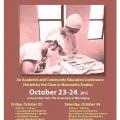
The poster for the conference, “Mennonites, Medicine and the Body: Health, Illness and Medical Research in the Past and Present,” held at Canadian Mennonite University in October 2015.
I had the privilege of participating in a conference this past weekend (Oct. 23, 24, 2015) at the University of Winnipeg hosted by Royden Loewen, the chair of Mennonite Studies. The theme was “Mennonites, Medicine, and the Body: Health, Illness and Medical Research in the Past and Present,” and it was a fascinating combination of medical, historical, literary, and theological perspectives.
Radio host Esther Horch, 1958
Radio host Esther Horch interviews school children live on a Saturday morning broadcast of Children’s Party in 1958. This education and entertainment show for children aired daily on CFAM from Altona, Man. Founded in 1956 by Mennonite shareholders, CFAM could reach 90 percent of Manitoba’s population.
Nurse Katherine Dyck, 1956
Mennonite Central Committee nurse Katherine Dyck poses with mothers and twins in Pusan, Korea, in 1956. Born in Russia in 1925, she immigrated to Rosthern, Sask., and worked as a nurse in Saskatchewan and Maryland before beginning service in Korea in 1953.
Anna Thiessen, Winnipeg missionary
Missionary to the city of Winnipeg, Anna Thiessen, is seated with some girls she worked with in 1919. Rural life has been an important part of Mennonite life and self-understanding. The city was seen as dangerous and unhealthy and therefore shunned. Mennonite Brethren missionary Anna Thiessen was one of the first Canadian Mennonites who chose to work in the city, beginning in 1915.





